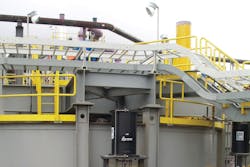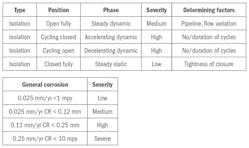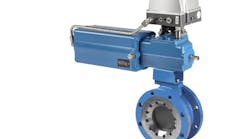Industry data indicate valves are used in many difficult applications. High temperatures, abrasive solids, corrosive fluids and rapid continuous cycling are challenging conditions. Isolation and control valves must be designed appropriately for these applications, which the valve industry refers to as “severe service.” The problem is that the category of severe service valves (SSVs) valves lacks a universal definition. However, that is changing since the Manufacturers Standardization Society (MSS) accepted the challenge to write a new standard practice to identify SSVs. The annual market for this segment of valves is estimated to be up to $14 billion per year.
Valves for mining
This article focuses on hydrometallurgical applications in mining. Since their invention, knife gate valves (KGVs) have been used in many services spanning general and severe service. Trial and error has produced new designs and options for old designs. The industry needs to be cautious because one must be familiar with several KGV designs since each has its own performance attributes and is best suited for particular applications.
A CGIS paper identified five distinct types of KGVs. Modern versions have pushed the operating envelope from low-pressure, 150-psig (10-Bar) general purpose valves up to and including ASME Class 600 (1440-psig, 100-Bar) severe service slurry isolation and control valves.
The most common style used in mining today — the push-through KGV — works well in low-pressure, low-cycle and neutral pH applications where its discharge causes no external problems.
However, in hydrometallurgical applications, acid leaching is commonly involved. Aside from the corrosive nature of the fluids, leaching dissolves solids and carries them throughout the piping system where they can precipitate out and coat the moving and sealing components of the valves. Push-through KGVs should not be selected for these applications.
When applications are corrosive with acidic solutions or have higher cycle frequencies and higher pressures, the use of push-through KGVs has proven problematic. This is because on every cycle, the valve produces a discharge, and more cycles produce greater discharge as the elastomer sleeves age and wear.
The nature of the push-through KGV design allows the body to be constructed of a material that does not necessarily have to be resistant to the process fluid because the valve’s elastomer sleeves fully isolate the body from the process. This observation is valid when the body is not subjected to corrosive attacks from valve discharges or leaks from the valve itself or surrounding equipment.
Push-through KGVs either freely discharge the process on every stroke (a discharge that grows with the number of cycles and age of the elastomers) or the discharge can be contained with the addition of a discharge containment plate or drainage system.
If a containment plate or system to control the discharge is added, ensure the materials are compatible with the process fluid. If acidic, the body needs to be corrosion-resistant as well. This defeats the cost-saving advantage of using the sleeves to protect the body from corrosion, as does the containment system cost.
For hydrometallurgical plants, push-through KGVs should not be used on applications that are acidic, require a reasonable number of cycles and operate at higher pressures, or for alkaline applications that exhibit substantial solids deposition (such as neutralization using lime).
Guided shear gate valve
A guided shear gate valve has the most features and best fundamental rugged design to operate in these challenging conditions and provide the best performance for the myriad of applications. These applications, requirements or conditions include:
- Pregnant acidic solutions
- High-frequency cycling
- Tight shut-off isolation
- Zero environmental impact
- High alloy bill of materials
- Higher pressure isolation
- Infrequent cycling
Isolation valves
For severe service isolation valves (SSIVs), the level of detail must go further than basic information of size, connection, piping materials, media, temperature, pressure, actuation, selected body and trim materials that is sufficient for general purpose valves (GPVs). It is essential to have a deeper understanding of the required cycling duty of the valve and media. GPVs are suited to benign fluid and process applications and should not be expected to work well in more challenging applications.
SSIVs are not just pieces of pipe; They are engineered products. Isolation valves have a dynamic phase when they cycle, and if this dynamic phase is not fully understood, one cannot fully predict the potential consequences.
The media may have different characteristics when flowing normally or when stopped. These conditions not only occur during the valve’s normally open or normally closed position, but depending on the type of valves, they can occur in trapped cavities within the valve.
If operators do not carefully analyze what these changes can do for the valve’s operating thrust or torque, they run the danger of underpowering the manual operators (handwheels or gears) or on/off or control actuators. This can lead to a valve that cannot provide the isolation or control duty for which it was designed.
No universal hard and fast rules on cylinder sizing exist. One uses the basic information provided on the valve data sheet: valve size, line design pressure, shut-off pressure, media (to ascertain a media factor for sizing), actuator power supply (pneumatic, electric or hydraulic) and actuator action (open, close or partially open or partially closed). One should be conservative with actuator sizing since five media factors (lubricating, clean and clear, mild slurry, severe slurry, scaling) affect the torque or thrust of a new valve. Valve values should be based on the highest design pressure load on the valve while using the lowest power value if there is a range, e.g., 80 for 80 to 120 psig air supply or 1,500 for 1,500 to 3,000 psig hydraulic supply.
Additionally, a generous safety factor is required to ensure the valve will cycle on demand after it has been installed and aged because of normal functioning. This safety factor costs, but it leads to a history of 100 percent success of availability of the valve on demand.
Lined knife gate valves
Lined KGVs have been used in several hydrometallurgical facilities with mixed results. The appeal of their use is that the liner can protect the body from corrosive solutions and can be made from an inexpensive material like ductile iron or carbon steel, which is cost-effective.
This is often a fallacy because the hydrometallurgical plant environment is as challenging outside the pipes as it is inside them.
Another consideration for some lined KGVs versus guided shear gate valves is the specific need for load distribution and filler rings and gaskets the valve requires when installed in certain piping types. Flange gaskets are required for some piping and not for others. Filler rings are installed in lined valves whereas load distribution rings are required with rubber-lined or PTFE-lined piping, but not for fiber-reinforced piping. Load rings are 0.50 inches thick and when required, are used on both sides of the valve, adding 1.0 inch to the valve face to face (which makes the lined valve noncompliant with industry applicable codes such as B16.10, MSS-SP-81 and 135).
Guided shear gates require no special rings and mate conveniently against flat and raised-face flanges with simple standard gaskets — no load or filler rings required.
Conclusion
In hydrometallurgical application one should use corrosion-resistant, wetted bodies, gates and seats for the specific corrosive fluids with larger manual operators or cylinders sized for the service requirements. If fail-safe cylinders are required, use with extended tie-rods to make sure the valve performs at its best, contributing to plant safety while reducing downtime.
High temperatures, abrasive solids, corrosive fluids and rapid continuous cycling are some conditions that challenge the valve industry. Isolation and control valves must be designed appropriately.
No clear or universal industry definition or mechanism exists to describe and accurately define SSVs from general-purpose valves, yet clients would benefit from such a definition with improved process performance, increased profitability, safety and environmental protection.
Most experts agree that SSVs are identified by applications, which are challenging to the valve’s ability to provide a minimum acceptable level of performance over a minimum acceptable duration.
SSVs can be found in nonreturn (check), isolation and control functions. The industry reasonably agrees on what can define severe service for severe service control valves (SSCVs). SSIVs do not have as clear agreement or understanding.
Nonreturn valves for severe service applications should be treated as control valves and sized so their operation is consistent with the flow rates of the process rather than with the pipe size for which they are typically selected.
Control valves take energy out of a piping system while isolation valves contain the energy and nonreturn valves delay and reduce the energy from its full effects on the isolation and control valves. All valve design functions require basic information, but valves destined for severe service require a deeper understanding of all the factors that affect their in-service performance.
Reference
- CGIS, Canada
Gobind Khiani is a professional engineer with more than 23 years of experience in the petroleum industry. He has a bachelor’s degree from the University of Pune in India and a master’s degree from the University of Calgary in materials and pipeline engineering. Over the past four years, Khiani has been a global piping valve subject matter expert in the Piping Department at Fluor.





